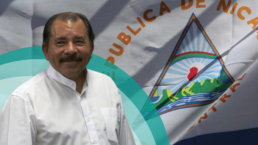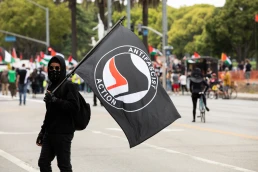By William I. Robinson, Nacla
With seven opposition presidential candidates imprisoned and held incommunicado in the months leading up to the vote and all the remaining contenders but one from miniscule parties closely allied with President Daniel Ortega and his Sandinista National Liberation Front (FSLN), the results of Nicaragua’s November 7 presidential elections were a foregone conclusion. The government declared after polls closed that Ortega won 75 percent of the vote and that 65 percent of voters cast ballots. The independent voting rights organization Urnas Abiertas, meanwhile, reported an abstention rate of approximately 80 percent and widespread irregularities at polling stations around the country
The vote was carried out in a climate of fear and intimidation, with a total absence of safeguards against fraud. In a complete breakdown of the rule of law, Ortega carried out a wave of repression from May to October, leading the opposition to issue a joint statement on October 7 calling for a boycott of the election. Several dozen opposition figures—among them, presidential candidates, peasant, labor, and student leaders, journalists, and environmentalists—were arrested and detained without trial, while several hundred others were forced into exile or underground.
Among those exiled were celebrated novelist Sergio Ramirez, who served as Ortega’s vice president during the 1980s revolution. While the government charged Ramirez with “conspiracy to undermine national integrity,” his crime was provoking the ire of the regime by publishing his latest novel, Tongolele No Sabía Bailar, a fictionalized account of the 2018 mass protests that marked the onset of the current political crisis and the degeneration of the regime into dictatorship. The book was promptly banned in the country, with customs authorities ordered to block shipments at ports of entry.
The repression particularly decimated the left-leaning opposition party Democratic Renovation Union (UNAMOS), formerly called the Sandinista Renovation Movement (MRS). The MRS was formed in 1995 by Ortega’s former comrades in arms who either left the FSLN after the failure of their efforts to democratize it or were expelled for challenging Ortega’s leadership of the party.
Among those UNAMOS leaders arrested and to date held incommunicado are legendary guerrilla commanders Dora María Téllez and Hugo Torres, as well as deputy foreign minister in the 1980s, Victor Hugo Tinoco, and party president Ana Margarita Vigil. Amnesty International condemned such detentions and incommunicado conditions as “enforced disappearance as a strategy of repression.”
As part of the crackdown the government also banned 24 civic organizations and professional associations—in addition to some 30 that it had previously banned, including three opposition political parties. The majority of these 24 organizations were professional medical guilds that had come under fire for criticizing the regime’s handling of the Covid-19 pandemic, including reporting that the government had concealed the number of infections and deaths. Vice President Rosario Murillo accused doctors of “health terrorism” and of spreading “false outlooks and news” on the impact of the contagion.
During the early months of the pandemic the government convened mass public events under the banner of “Love in Times of Covid.” Nicaragua, together with Haiti, has the lowest rate of vaccination in Latin America, with only 4.9 percent of the population inoculated as of October.
In late 2020, the Sandinistas decreed a spate of laws that allows authorities to criminalize anyone who speaks out against the government. Among these are a Cybercrime Law that allows fines and imprisonment of anyone who publishes in the press or on social media what the government deems to be “false news.” Meanwhile, a “hate crimes” law allows life sentences for anyone considered to have carried out “hate crimes,” as defined by the government. Among the varied offenses listed by Sandinista prosecutors for the recent wave of detentions are “conspiracy to undermine national integrity,” “ideological falsehood,” “demanding, exalting, or applauding the imposition of sanctions against the Nicaraguan state and its citizens,” and “using international funding to create organizations, associations, and foundations to channel funds, through projects or programs that deal with sensitive issues such as sexual diversity groups, the rights of Indigenous communities, or through political marketing on topics such as free expression or democracy.”
A week before the vote, Ortega proclaimed that his wife, Vice President Rosario Murillo, was henceforth the “co-president” of the country. While his bizarre declaration has no legal basis or constitutional legitimacy, it was widely seen as a move to anoint her as his successor—the 76-year-old Ortega is known to be in ill health—and a further step towards the rule of a family dynasty. The ruling couple’s eight children already serve as advisors to the presidency and manage the family’s empire of private and ostensibly public media outlets, investment funds, and family businesses.
A mid-October poll by CID-Gallup—an independent pollster that has been conducting political opinion surveys in the country since 2011—found that 76 percent of the country’s electorate believed the country was moving in the wrong direction. The poll reported that 19 percent of the electorate planned to vote for Ortega, 65 percent stated they would favor an opposition candidate, and 16 percent remained undecided. A rival pollster contracted by the FSLN, M&R, showed Ortega with nearly 80 percent support.
While all polls should be assessed with caution given the methodological limitations to surveys conducted amid political instability and civil conflict, it is noteworthy that Ortega’s support dropped to 19 from the 33 percent support reported by a CID-Gallup survey conducted in May of this year, which in turn was down from the high point of popular support for Ortega, 54 percent, registered in CID-Gallup’s 2012 poll.
Now that the votes have been cast, it is impossible to get accurate figures for the results given that the Sandinistas control the Supreme Electoral Council and exercise a near absolute control over reporting on the results. In addition, independent foreign observers were banned, and the threat of repression has dissuaded journalists and civic organizations from speaking out.
Ortega will now start his fourth consecutive term in office since the FSLN returned to power in 2007 in the midst of economic and political crisis. With its legitimacy shattered in the aftermath of the 2018 mass uprising and its violent repression, the regime has to rely more on direct coercion to maintain control. After the economy contracted each year from 2018 to 2020, the United Nations Economic Commission for Latin America estimates a 2.0 percent growth rate for the current year and 1.8 percent for 2022—not enough for the economy to recover from the three-year tumble.
As the crisis has intensified, the number of Nicaraguans trying to cross the U.S.-Mexico border climbed to historically unprecedented levels to exceed 50,000 this year, compared to just a few thousand in 2020. These numbers are in addition to the 140,000 who had already fled into exile since 2018, mostly to Costa Rica.
The International Left Remains Divided on Nicaragua
The international left remains divided on the Nicaraguan crisis, with some among it arguing that the Ortega-Murillo regime represents a continuation of the 1980s revolution and that the United States has been attempting to overthrow it. However, as I showed in an earlier NACLA article, there is little evidence to corroborate the claim that the 2018 mass uprising was instigated by Washington in an attempt to carry out a coup d’état against the government, or that the United States has since carried out a destabilization campaign aimed at overthrowing the regime.
The Ortega inner circle hacked its way into the ranks of the country’s elite in the aftermath of the 1980s revolution and launched a new round of capitalist development starting in 2007. During this period, the Sandinista bourgeoisie set about to vastly expand its wealth. Leading Sandinistas grouped around Ortega heavily invested in tourism, agroindustry, finance, import-export, and subcontracting for the maquiladoras.
Ortega and Murillo championed a program—dressed in a quasi-leftist discourse of “Christian, Socialist, and Solidarity”— of constructing a populist multiclass alliance under the firm hegemony of capital and Sandinista state elites. This model did improve material conditions until the economy began to tank in 2015. It was not until the mass protests of 2018 that the co-government pact that Ortega had negotiated with the capitalist class, organized into the Superior Council of Private Enterprise (COSEP), broke down.
Washington would have liked to have a more pliant regime in place from the start, and the recent events have upped the ante in U.S.-Nicaragua relations. Nonetheless, successive U.S. administrations accommodated themselves since 2007 to the Ortega government, which cooperated closely with the U.S. Southern Command, the Drug Enforcement Agency, and U.S. immigration policies. Although the U.S. Agency for International Development (USAID) has supplied several million dollars to opposition civic organizations through the National Endowment for Democracy (NED), USAID also granted several hundred million dollars directly to the Ortega government from 2007 until 2018.
On the eve of the Nicaraguan vote, the U.S. Congress passed the RENACER Act, which calls for targeted sanctions on Nicaraguan government officials found guilty of human rights violations and corruption. It also requires the executive branch to determine if Nicaragua should be expelled from the Central American Free Trade Agreement and to “expand oversight” of lending to Nicaragua by international financial agencies. In 2017 the U.S. government passed almost identical legislation, the NICA Act, which to date has resulted in sanctions slapped on several dozen top Nicaraguan government officials, affecting the assets they hold in the United States.
Apart from these sanctions on individuals, however, Washington did not enforce the NICA Act. It did not apply trade sanctions and has not blocked Nicaragua from receiving billions of dollars in credits from international agencies. From 2017 to 2021, Nicaragua received a whopping $2.2 billion in aid from the Central American Bank of Economic Integration (BCIE), and in 2020-2021 it received several hundred million in credits from the Inter-American Development Bank, the World Bank, and the International Monetary Fund.
Some among the international Left condemn calls for sanctions on Ortega. Yet the U.S. and international Left broadly mobilized (unsuccessfully) in 1978 and 1979 to force Washington to impose sanctions on the Somoza dictatorship and block international financing because of the regime’s gross human rights violations. The worldwide Left similarly demanded sanctions against apartheid South Africa, sought to block U.S. and international financing for the Pinochet dictatorship, and currently calls for “boycott, divestment, and sanctions” against Israel.
Grassroots opponents of the Ortega-Murillo regime find themselves between the rock of an Ortega-Murillo dictatorship and the hard place of the capitalist class and its political agents among the traditional conservative parties. The Right—just as disturbed as Ortega by the outburst of popular protest from below in the 2018 uprising—tried to hitch mass discontent to its own agenda of recovering direct political power and assuring there would be no threat to its control over the Nicaraguan economy.
It was the government’s repression of the popular uprising of students, workers, feminists, and environmentalists that paved the way for the Right’s current hegemony over the anti-Sandinista opposition. The mass of Nicaraguans—beyond the Sandinistas’ secure base in some 20 percent of the population—have not shown any enthusiasm for the traditional conservative parties and businessmen that dominate the opposition and have no real political representation. Indeed, the October CID-Gallup poll found that 77 percent of the country’s electoral does not feel represented by any political party.
Recent Posts
Elon Musk Is Vowing Utopia Driven by AI and Robotics. Bernie Sanders Has a Few Questions
December 20, 2025
Take Action Now “I look forward to hearing about how you and your other oligarch friends are going to provide working people with a magnificent life…
U.S. Military Willing To Attack “Designated Terrorist Organizations” Within America, General Says
December 19, 2025
Take Action Now “If I had no concerns and I was confident in the lawful order, I would definitely execute that order.”By Nick Turse, The……
DOJ Won’t Meet Friday Deadline To Release All The Epstein Files
December 19, 2025
Take Action Now The delay means the White House is in apparent conflict with a law President Donald Trump signed in November.By Gregory…
Privatize USPS? Mail Carriers Have A Better Idea
December 18, 2025
Take Action Now After battling for a fair contract, USPS workers face the threat of privatization, which they warn will harm all Americans.By Mel…





